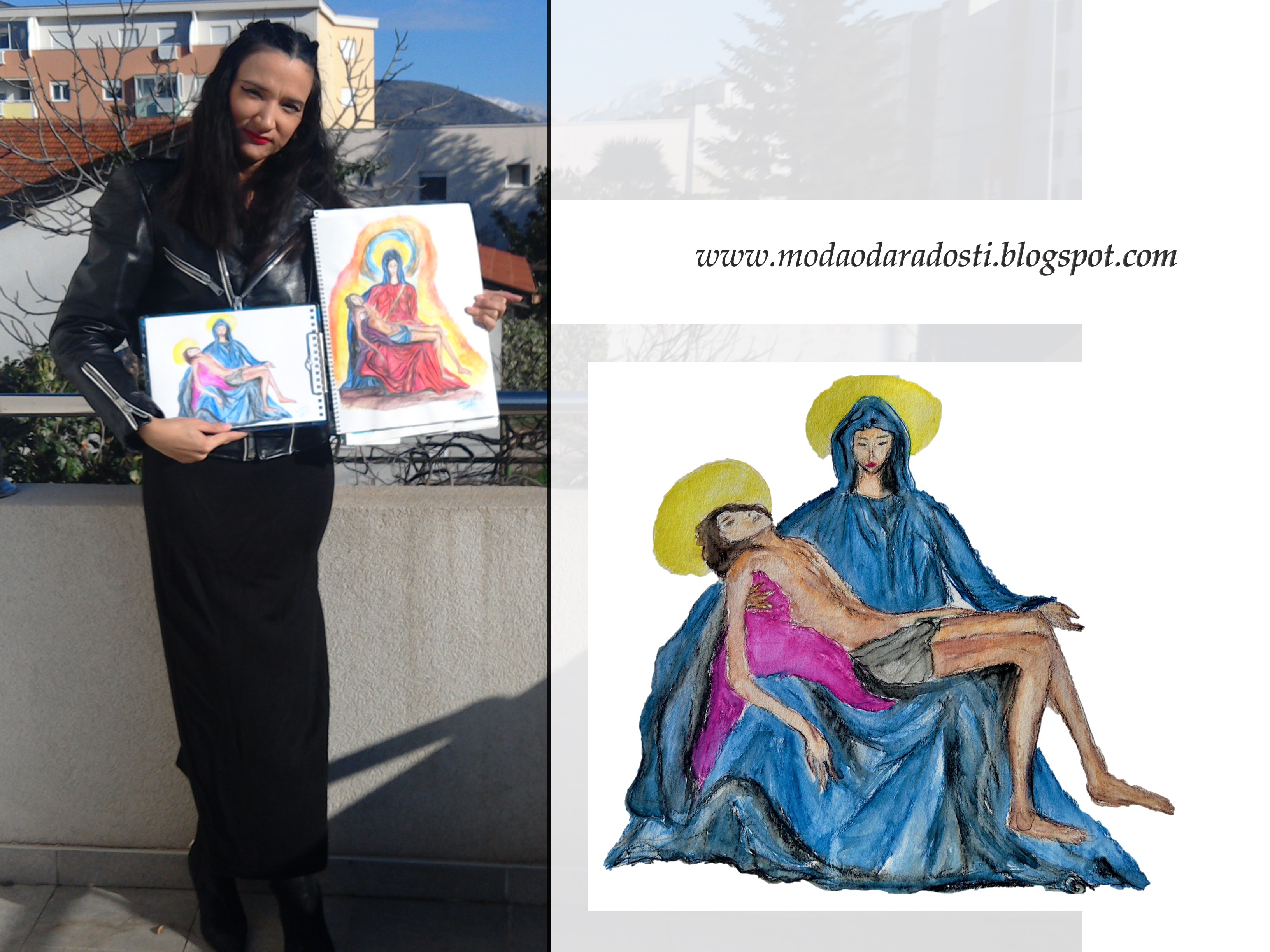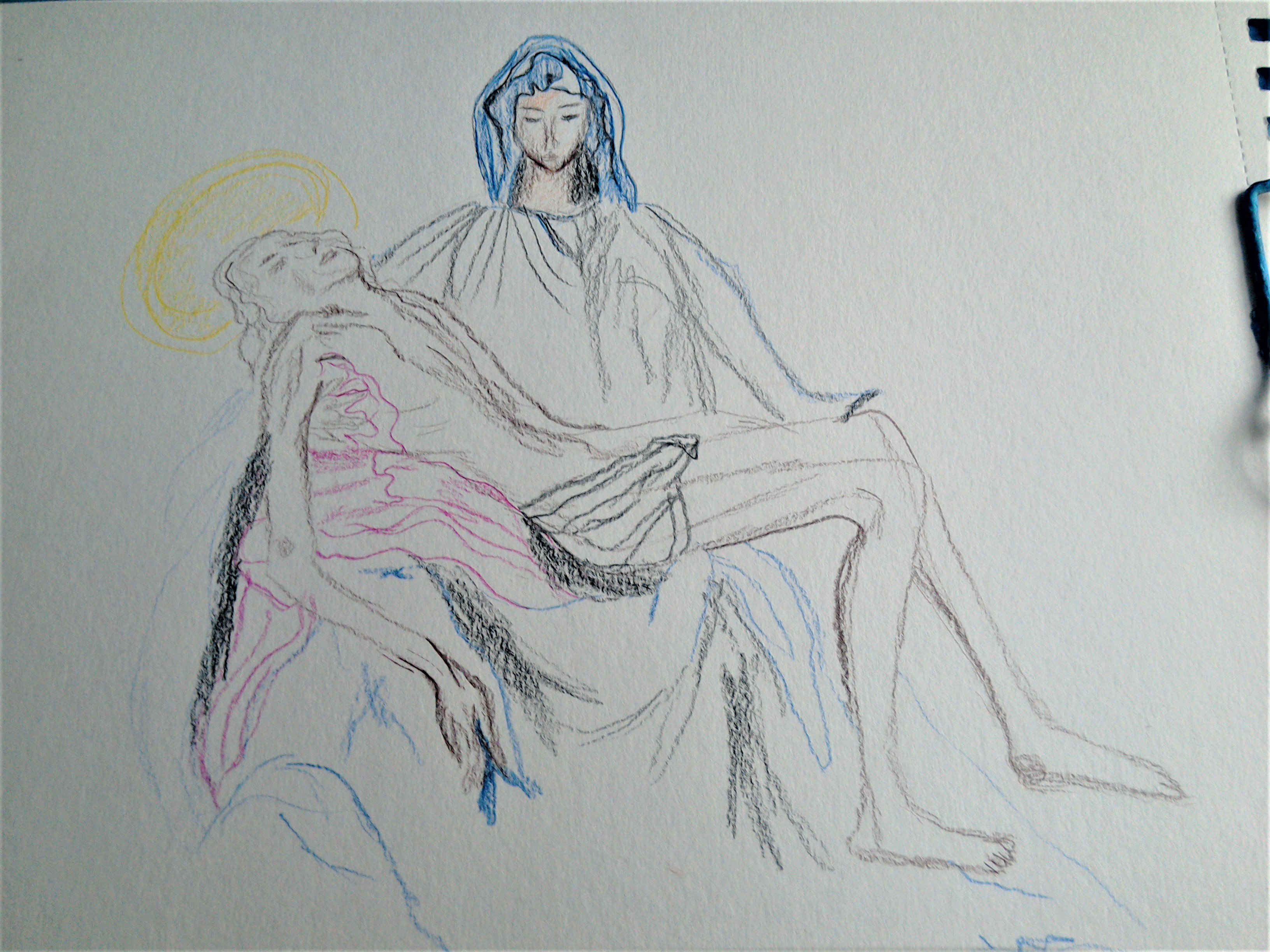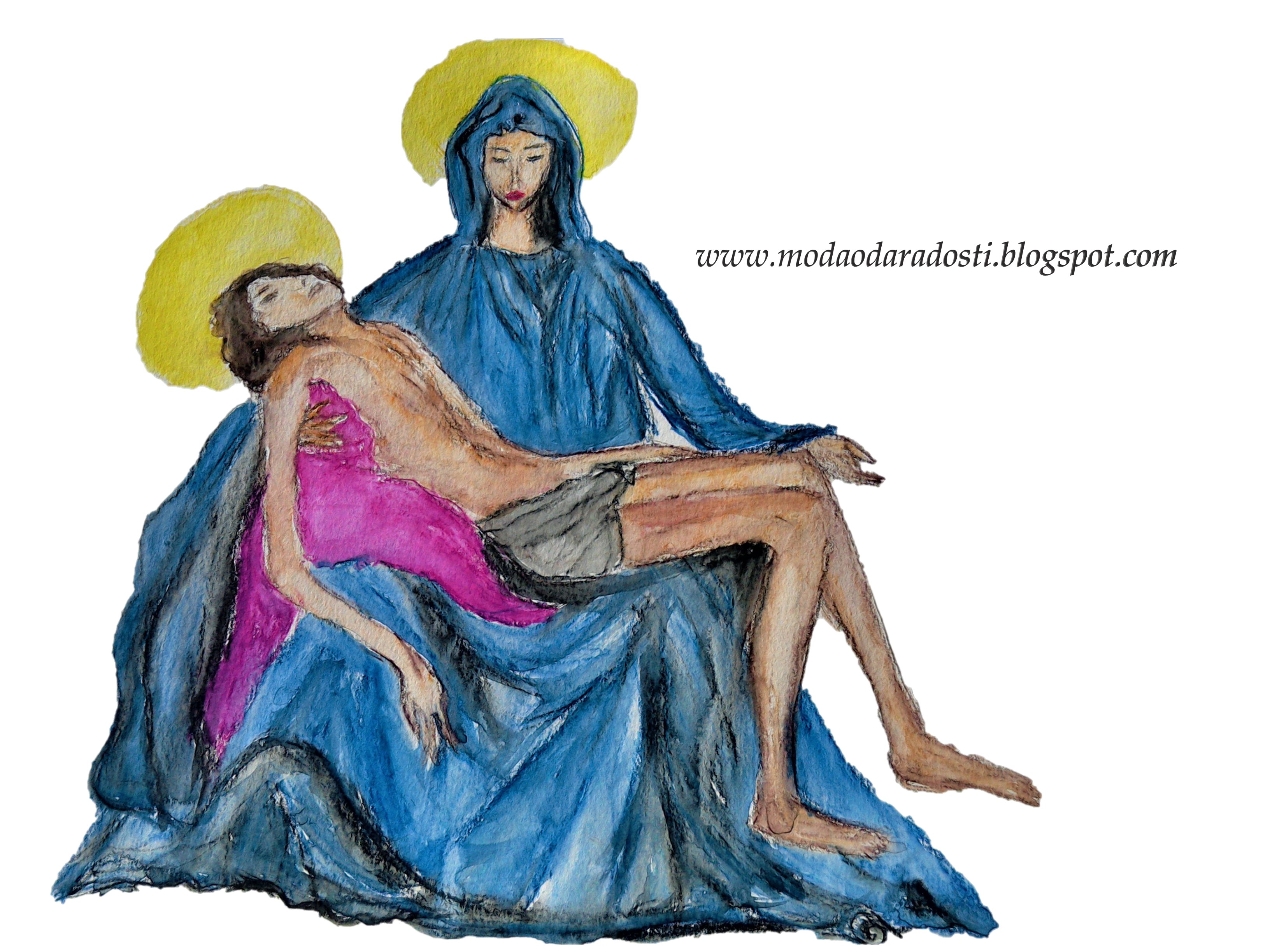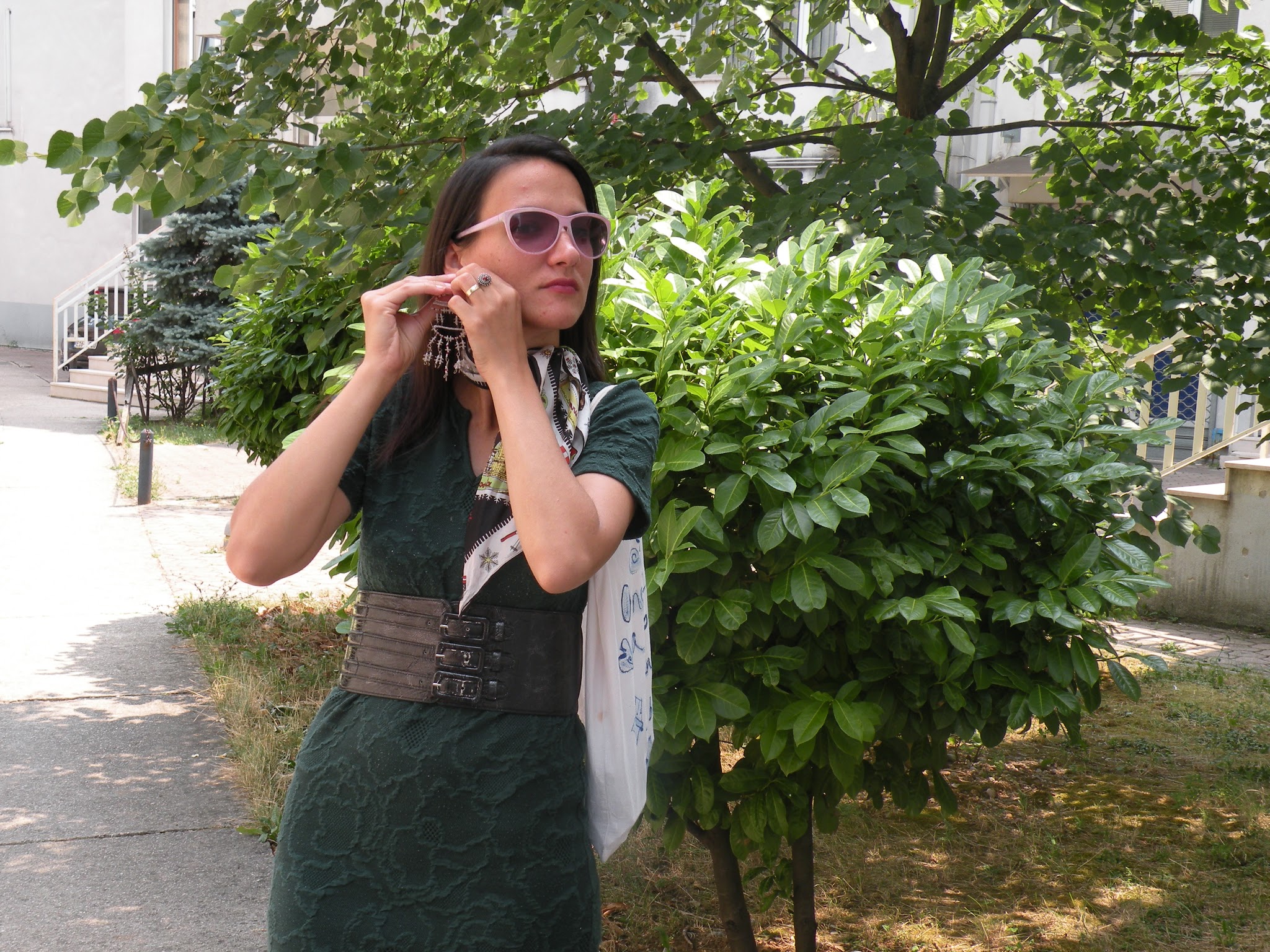In this post, I will share a watercolour painting of mine with a spiritual theme. I was inspired by a classical work of art, a rather famous sculpture created by Michelangelo Buonarroti five hundred and twenty-one years ago. This is actually my second study of this marble sculpture. If you remember I already shared with you a watercolour pencil study of Michelangelo's Pieta here. That first study painting was made in A3 format while this newer study of Pieta is in A4 format. That's not the only difference between them. These watercolour sketches are somewhat different one from another both in terms of colour and composition. Moreover, these two watercolour studies are not identical to the sculpture reference itself, as I took some creative liberties with these studies. Obviously
, the marble sculpture is monochrome
and lacking colours. I used different colours in my studies of it and took other creative liberties. I might do another study of this sculpture some time in the future because I find it very inspirational.

I used the same photograph from a Vatican book as a reference for both of these, you will be able to see it below. I have Pieta photographs I have taken myself nine years ago, when I visited Vatican city (and Rome obviously) but using the book reference
was more convenient this time
. Among the incredible art I have seen in Vatican city, one work in particular stood out for me and it was this one: Michelangelo's Pieta (Pietà). This magnificent statue is the only work Michelangelo's ever signed. It is hard to believe Michelangelo's was only twenty-three years old when he created this incredible work- the marble sculpture depicting Virgin Mary and Christ. What a masterpiece it is! I do still remember how I admired it back when I had the pleasure to visit Vatican myself (you can read more about my visit to Rome here, here, here ). So, I had the opportunity to behold this masterpiece with my own eyes. As you can see, it continues to inspire it and that is why I will probably paint it again.
On a more personal note, the start of January was difficult for me. I lost a close family member and that's why I took a few days off blogging. My beloved grandmother passed away. The fact that she was not young anymore, doesn't make the loss any less significant. It's always hard to lose someone you love, to say that final goodbye. My grandmother meant a great deal to me. Being a creative and artistic person herself, my grandmother was always extremely supportive of all my creative pursuits. She was sometimes present on my blog, if you missed those posts or you would like to see her again, you may visit this post here . As for my outfit, I'm shopping my closet again. I'm wearing a vintage leather jacket I got from my husband and a black maxi dress I got from his niece plus a pair of black boots from Peko.
HR Danas ću podijeliti sa vama svoj akvarel duhovne tematike. Nadahnulo me klasično umjetničko djelo, prilično poznata skulptura koju je stvorio Michelangelo Buonarroti prije petsto dvadeset i jednu godinu. Ovo je zapravo moja druga studija ove mramorne skulpture. Ako se sjećate, ovdje sam s vama već podijelila sliku Michelangelove Piete rađenu akvarel bojicama. Ta prva slika napravljena je u A3 formatu dok je ova novija Pietina studija u A4 formatu. To nije jedina razlika među njima. Ove akvarelne skice se donekle razlikuju jedna od druge i po boji i po kompoziciji. Štoviše, ove dvije slike nisu identične samoj referenci skulpture, budući da sam uzela neke kreativne slobode s ovim slikama. Očito je sama mramorna skulptura jednobojna. Koristila sam različite boje u ovim slikama pa i uzimala druge kreativne slobode. Možda ću u budućnosti još jednom naslikati ili nacrtati ovu skulpturu jer smatram da je vrlo zanimljiva i nadahnujuća.
Koristio sam istu fotografiju iz vatikanske knjige kao referencu za obje slike, moći ćete ju vidjeti u nastavku. Imam Pietine fotografije koje sam sam snimio prije devet godina, kada posjetih Vatikan (i Rim ), ali ovaj put je korištenje reference iz knjige bilo zgodnije. Među nevjerojatnim umjetninama koje vidjeh u Vatikanu, posebno mi se svidjelo jedno djelo, a to je upravo ovo: Michelangelova Pieta (Pietà). Ovaj veličanstveni kip jedino je djelo koje je Michelangelo ikada potpisao. Teško je povjerovati da je Michelangelo imao samo dvadeset i tri godine kada je stvorio ovo nevjerojatno djelo - mramornu skulpturu koja prikazuje Djevicu Mariju i Krista. Kakvo je to remek djelo! Još uvijek se sjećam kako sam mu se divila kada sam imala zadovoljstvo posjetiti Vatikan (više o mom posjetu Rimu možete pročitati prateći poveznice u engleskom dijelu teksta). Dakle, imala sam priliku vlastitim očima vidjeti ovo remek-djelo. Kao što vidite, nastavlja me inspirirati i zato ću ga vjerojatno ponovno naslikati.
Što se tiče osobnog živta, početak siječnja bio je težak. Izgubila sam bliskog člana obitelji i zato sam uzela nekoliko dana odmora od bloga. Preminula je moja voljena baka. Činjenica da više nije bila mlada ne čini gubitak ništa manje značajnim. Uvijek je teško izgubiti nekoga koga voliš, reći konačno zbogom. Moja baka mi je puno značila. Kako je i sama kreativna i umjetnička osoba, moja baka je uvijek bila puna podrške kada je bila riječ o mojim kreativnim pothvatima. Ponekad je bila prisutna na mom blogu, ako ste propustili te objave ili biste je htjeli ponovno vidjeti, možete to učiniti ovdje. Što se moje odjeće tiče, opet kupujem iz svoga ormara, održiva moda i tako to. Nosim vintage kožnu jaknu koju sam dobila od muža i crnu dugu haljinu koju sam dobila od njegove nećakinje te par crnih čizama iz Peka (u engleskom dijelu teksta možete pronaći poveznice na ove odjevne komade to jest na druge objave sa njima).


EN
THE MAKING OF A WATERCOLOUR STUDY OF PIETA
Well, the process was fairly simply. I sketched the two figures and then I added water because I was using watercolour pencils. Both the watercolour pencils and the mixed media paper are from
Staedtler (neither sponsored, nor affiliated).
This time I used blue to colour Mary's garments, not red. One could make theological arguments for her wearing both of these colours. In art, Mary was portrayed as wearing both red (a symbol of passion, love and devotion) and blue (a symbol of sky, purity and royalty). Another thing that I did differently was to add less details. This particular watercolour study is less detailed and more flowing.
HR
IZRADA AKRILNE SKICE PIETE
Sam proces je bio prilično jednostavan. Skicirala sam dvije figure, a zatim dodala vodu jer sam koristila akvarel olovke. Akvarel bojice i višenamjenski papir (za razne medije) su iz Staedtlera (nisu sponzorirani).
Ovaj put sam koristila plavu boju za Marijinu odjeću, a ne crvenu. Mogli bi se iznijeti teološki argumenti za njeno nošenje obje ove boje. U umjetnosti je Marija bila prikazana kako nosi i crvenu (simbol strasti, ljubavi i odanosti) i plavu (simbol neba, čistoće i kraljevstva). Druga stvar koju sam učinila drugačije je što sam dodala manje detalja. Ova studija akvarela manje je detaljna i protočnija.
FOR THOSE WHO WANT TO KNOW MORE.....
The Pietà (Italian: [pjeˈta]; English: "the Piety"; 1498–1499) is a work of Renaissance sculpture by Michelangelo Buonarroti, housed in St. Peter's Basilica, Vatican City. It is the first of a number of works of the same theme by the artist. The statue was commissioned for the French Cardinal Jean de Bilhères, who was the French ambassador in Rome. The sculpture, in Carrara marble, was made for the cardinal's funeral monument, but was moved to its current location, the first chapel on the north side after the entrance of the basilica, in the 18th century.[1] It is the only piece Michelangelo ever signed. It is also the only known sculpture created by a prominent name from the Renaissance era to be installed in St. Peter's Basilica that was accepted by the Chapter of St. Peter. [2]
This famous work of art depicts the body of Jesus on the lap of his mother Mary after the Crucifixion. Michelangelo's interpretation of the Pietà is unprecedented in Italian sculpture.[3] It is an important work as it balances the Renaissance ideals of classical beauty with naturalism. *
The structure is pyramidal, and the vertex coincides with Mary's head. The statue widens progressively down the drapery of Mary's dress, to the base, the rock of Golgotha. The figures are quite out of proportion, owing to the difficulty of depicting a fully-grown man cradled full-length in a woman's lap. Much of Mary's body is concealed by her monumental drapery, and the relationship of the figures appears quite natural. Michelangelo's interpretation of the Pietà was far different from those previously created by other artists, as he sculpted a young and beautiful Mary rather than an older woman around 45 years of age.[5]
The marks of the Crucifixion are limited to very small nail marks and an indication of the wound in Jesus' side.
Christ's face does not reveal signs of the Passion. Michelangelo did not want his version of the Pietà to represent death, but rather to show the "religious vision of abandonment and a serene face of the Son,"[6][better source needed] thus the representation of the communion between man and God by the sanctification through Christ.
When Michelangelo set out to create his Pietà, he wanted to create a work he described as "the heart's image".
*cited from wikipedia.


ZA ONE KOJI ŽELE ZNATI VIŠE....
Pietà [~ta'] (talijanski pietà: sućut, samilost, milosrđe) (hrvatski Bogorodica sućutna, njemački Vesperbild), u zapadnoj kršćanskoj umjetnosti, ikonografski motiv sa sjedećim likom Majke Božje koja u krilu drži mrtvo Isusovo tijelo nakon skidanja s križa. Počeo se javljati oko 1320. u rajnskom području, odakle se širio njemačkim, češkim, francuskim i prialpskim krajevima (Slovenija, Istra, Venecija, Furlanija, gornja Italija) i trajao sve do XVI. st. U Njemačkoj je dobio naziv Vesperbild, od lat. Vesperae: Večernja (molitva u časoslovu), jer je Isusovo tijelo bilo skinuto s križa predvečer. Isprva, u XIV. st., mrtvo Isusovo tijelo sjedi okomito u majčinu krilu, nagnute glave, a Marija ne plače; ona, zapravo, pokazuje pobožnomu gledatelju mrtvoga Sina i time ističe misao da je njegovom smrću izvršeno i dovršeno djelo otkupljenja; sredinom XIV. st. tijelo je u njezinu krilu položeno dijagonalno, a početkom XV. st. trup joj leži u krilu vodoravno; potkraj XV. i u XVI. st. tijelo klizi iz njezina krila na tlo, gdje sjedi ili leži, a Marija pridržava samo glavu ili ramena. *
Pietà je prvo slavno djelo Michelangela i ujedno prvo potpisano djelo ovog najvećeg umjetnika visoke renesanse.Skulptura predstavlja mladoliku Gospu koja oplakuje Isusa u svom naručju tvoreći jasnu piramidalnu kompoziciju na ovalnoj bazi. Michelangelova iznimno ljupka i mladolika Gospa koja sjedi na Golgoti predstavlja Crkvu kao vrata prema Nebesima. Prema jednoj legendi, kada su Michelangela upitali zašto je prikazao Gospu toliko mladu da bi mogla biti Isusovo godište, on je odgovorio kako je Gospina mladost rezultat njene čestitosti. Na ovom prikazu nema isticanja emocija kao kod njemačkog Andachtsbilda (vidi: Roettgen Pietà) jer se cilj prikaza pomiče sa suosjećanja Gospine tuge na središnji misterij kršćanstva: Isusa kao Boga u ljudskom obličju koji se žrtvovao kako bi otkupio ljudske grijehe. Michelangelo je Gospin lik preuzeo iz djela Jacopa della Quercia (tijelo) i Verrochija (otmjeno lice i dekorativna draperija). Vijugavo Isusovo tijelo leži preko Marijinih koljena ogrnutih velikim ogrtačem, dok njena ruka ponavlja taj položaj svojom ispruženom lijevom rukom. Ogrtač koji kao da teče preko Gospina tijela je omogućio Michelangelu da fizički poveže Gospu s Isusom čime je istaknuo njihovu duhovnu povezanost. Njih dvoje su toliko povezani da rijetki uoče relativni nesrazmjer veličina tijela Gospe i Isusa. Giorgio Vasari, najveći biograf renesansnih umjetnika, navodi ovo djelo kao: "najljepši mramor u Rimu koje ne može nadmašiti nijedan živući autor … utjelovljenje svih mogućnosti i snage koju može imati umjetnost kiparstva". * citirano s wikipedije.
Michelangelo Buonarroti [mikela'n elo buonar:ɔ:'ti] (pravo ime Michelangelo di Lodovico Buonarroti Simoni), talijanski kipar, slikar, graditelj i pjesnik (Caprese, danas Caprese Michelangelo, provincija Arezzo, 6. III. 1475 – Rim, 18. II. 1564). Glavni predstavnik visoke renesanse i preteča manirizma. Školovao se u Firenci u slikarskoj radionici D. Ghirlandaia, gdje je naučio tehniku fresko-slikarstva i slikanja uljem. Proučavao je i kopirao djela Giotta i Masaccia. God. 1489. primljen je u kiparsku školu u vrtu Medicija koju je vodio Bertoldo di Giovanni, Donatellov suradnik. Neko je vrijeme živio na dvoru Lorenza Veličanstvenoga, gdje je proučavao njegovu zbirku antičkih skulptura i stekao, u krugu pjesnika i učenjaka neoplatonista, humanističko obrazovanje. Uoči pada Medicija otišao je u Bolognu (1494–95), a 1496–1500. boravio je prvi put u Rimu, gdje je studirao antička djela i izradio veći broj kipova od kojih se ističu Bakho (1497) i njegovo jedino potpisano djelo Pietà (1498–1500).......
elo buonar:ɔ:'ti] (pravo ime Michelangelo di Lodovico Buonarroti Simoni), talijanski kipar, slikar, graditelj i pjesnik (Caprese, danas Caprese Michelangelo, provincija Arezzo, 6. III. 1475 – Rim, 18. II. 1564). Glavni predstavnik visoke renesanse i preteča manirizma. Školovao se u Firenci u slikarskoj radionici D. Ghirlandaia, gdje je naučio tehniku fresko-slikarstva i slikanja uljem. Proučavao je i kopirao djela Giotta i Masaccia. God. 1489. primljen je u kiparsku školu u vrtu Medicija koju je vodio Bertoldo di Giovanni, Donatellov suradnik. Neko je vrijeme živio na dvoru Lorenza Veličanstvenoga, gdje je proučavao njegovu zbirku antičkih skulptura i stekao, u krugu pjesnika i učenjaka neoplatonista, humanističko obrazovanje. Uoči pada Medicija otišao je u Bolognu (1494–95), a 1496–1500. boravio je prvi put u Rimu, gdje je studirao antička djela i izradio veći broj kipova od kojih se ističu Bakho (1497) i njegovo jedino potpisano djelo Pietà (1498–1500).......
U svestranoj stvaralačkoj djelatnosti Michelangelo je prije svega kipar. Polazeći od antičkih uzora i zrelog izraza visoke renesanse, stvorio je vlastiti likovni svijet elementarne snage i neprolazne ljepote. Figuru čovjeka, koja ga kao plastički fenomen jedina zanima, daje u anatomski jasnoj modelaciji, u monumentalnom volumenu i u njezinoj punoj ljudskosti. Prvi radovi još pokazuju suzdržane oblike (Pietà; David, simbol pobjede ideje slobode nad tiranijom), koji su bujali u potonjim likovima, osobito Mojsiju i nedovršenim Robovima za grobnicu Julija II., a u posljednjem se razdoblju, kao konačna sinteza, smiruju na monumentalnim figurama simbolima prolaznosti (likovi Dana, Noći, Zore i Sutona) na sarkofazima Giuliana i Lorenza Mlađega Medicija.
....
Kao graditelj, Michelangelo unosi nove elemente u shvaćanje prostorne funkcije objekta kao cjeline i u njegovo oblikovanje. Već je njegov suvremenik G. Vasari jasno uočio da Michelangelo graditeljski stvara nov stil, dajući renesansnoj koncepciji smirenosti, arhitektonskoga sklada i stroge proporcionalnosti potpuno individualnu notu unutarnje dinamike kojom je nagovijestio pojavu manirizma, odn. ranoga baroka. Projektirao je veći broj arhitektonskih tlocrta i nacrta, ali je ostvario samo grobnu kapelu Medicija i dijelove firentinske Biblioteke Laurenziane (stubište, uzor svim potonjim baroknim koncepcijama). Nakon smrti A. da Sangalla (1547) postao je glavni graditelj bazilike sv. Petra u Rimu. Modificiravši prvotni Bramanteov plan, Michelangelo je koncipirao jedinstven i monumentalan prostor s dominantnom kupolom (visina 138 m), koja je dovršena tek nakon njegove smrti. Po njegovim nacrtima riješen je prostor trga na Kapitoliju: uokviruju ga tri palače (Palazzo Senatorio, Palazzo dei Conservatori i Museo Capitolino), između kojih je smještena rimska konjanička statua Marka Aurelija. Michelangelo je naslijedio Sangalla i kao arhitekt palače Farnese, koja je djelomično izgrađena po njegovim nacrtima. Izravnih učenika nije imao, ali je snagom svojega umjetničkoga genija silno utjecao ne samo na suvremenike kipare nego i slikare (Rafaela, Andreu del Sarta, A. Bronzina, Pontorma, Correggia, Parmigianina, Tiziana, Tintoretta) te na naraštaje umjetnika potonjih razdoblja. Pisao je sonete (najljepši su posvećeni Vittoriji Colonni), madrigale, kancone, epigrame i epitafe. Njegova kuća u Firenci pretvorena je u muzej (Casa Buonarroti). *
*Michelangelo Buonarroti. Hrvatska enciklopedija, mrežno izdanje. Leksikografski zavod Miroslav Krleža, 2021. Pristupljeno 9. 1. 2022. <http://www.enciklopedija.hr/Natuknica.aspx?ID=40550>.
Thank you for visiting!
Hvala na posjeti!
elo buonar:ɔ:'ti] (pravo ime Michelangelo di Lodovico Buonarroti Simoni),





















Dig That Balcony There - And That Is Quite The Darth Vader Outfit As Well - Amazingly Creative Piece Of Work - Always Enjoy Inspecting Your Style For Sure - Big Hugs My Friend
ReplyDeleteCheers
Thank you!
DeleteSo sorry to read about the loss of your grandmother in this life. Grandmother's can hold such an important and honored place in our world. My grandmother was the most influential person I aspired to be like and hopefully your memories with your grandmother will carry you and continue to bring you joy.
ReplyDeleteGlad to see you're still painting. I followed your blog years ago and happy to find you again because you inspire me to be more creative!
Thank you so much for your comment. Grandmothers can be incredibly special. I remind myself how happy I was to have had mine, even if she is no longer with me, I still have memories of her (as you say). Thank you for saying I inspire you to be more creative.
DeleteHi
ReplyDeleteIt is with sadness that I read that you lost your dear grandmother and know that she supported you so much in your artwork and on the blog!
As for your works, I liked the colors that you used in this A4 study! It is indeed a masterpiece that leaves us speechless!
You look great with that make up and I also really liked your outfit even though I understand why you're in black!
xoxo
marisasclosetblog.com
Thank you dear Marisa.
DeleteI'm so sorry to hear of your grandmother's passing, and would like to offer your my sincerest condolences. You are so right, it doesn't matter how old somebody is, it is always a keenly felt loss.
ReplyDeleteYour piety study is very striking, and so is your all-black outfit. Sending warm hugs xxx
Thank you dear Ann. xoxo
DeleteSo sorry to hear of the loss of your grandmother, what a sad way to start the year :(
ReplyDeleteIn a lighter note these watercolours are lovely - it's nice you added colour.
Thank you.
DeleteDraga Ivana, zao mi je cuti za tvoju baku, primi moju sucut. Ja sam svoju bakicu izgubila u srpnju, a bila mi je kao mama jer sam sa njom odrasla, tako da me to jako potreslo (iako sam ocekivala da ce se to desiti, jer je bila tesko bolesna) i jedino sam se tjelovjezbom izvukla iz tog depresivnog stanja. Tako da te savrseno razumijem. Imala sam i osjecaj da se jedna zivotna era zavrsila (napunila sam 40 godina i ostala bez bake), kao da je na neki nacin i moja mladost otisla sa njom. Ali, naravno, ne smijem tako razmisljati, ona bi zeljela da ja budem leprsava, vesela, bezbrizna, kao nekad. Tako da te u potpunosti razumijem i saljem veliki zagrljaj. Nase bakice ce uvijek biti sa nama!
ReplyDeletehttp://www.soniaverardo.com/
Hvala, ja sam također u neku ruku očekivala, ali opet je teško. Doista je kao da završi jedna životna era kada izgubimo bake. Svakako bi one željele da i dalje u životu budemo radosne kada možemo. Meni tjelovježba također pomaže u borbi protiv depresije i drugih zdrastvenih problema koje sam imala u zadnje vrijeme. Hvala ti puno na komentaru.
DeleteHo sempre amato la Pietà di Michelangelo e tu sei bravissima!
ReplyDeleteKisses, Paola.
Expressyourself
My Instagram
Grazie Paola <3
DeleteI am so sorry about your grandmother. It's truly never easy to lose someone we love, and the loss is so hard. I love that she was a creative like you were, and with your talent, no doubt she was proud.
ReplyDeleteSending love and hugs Ivana.
XOOX
Jodie
www.jtouchofstyle.com
Thank you dear Jodie.
DeleteOh, honey, I am so sorry to hear of your family's loss with your grandmother's passing. It isn't easy, no matter what age our loved ones are when they leave us. *hug*
ReplyDeleteI like that you explored your images of the Pieta in different ways. I'm boggled at the genius of Michaelangelo - at 23!! - doing that statue so young.
Love your leather jacket!
Thank you very much. It's hard.
DeleteYes, he was only 23. That's the reason why he signed it. Nobody believed such a young artist could create such a masterpiece. He had to sign it to prove it. If I'm not mistaken, that's the only artwork he has ever signed (though he did paint himself in some paintings, other artists sometimes signed themselves that way too).
Siento mucho lo de tu abuela. Me gusta mucho tu pintura te quedo muy impactante. Te mando un beso
ReplyDelete<3<3
DeleteSo sorry to hear about your grandmother. Thanks for the very spiritual post. Hope you are doing OK.
ReplyDeleteThank you. I'm doing OK.
DeleteI'm so sorry for your loss, Ivana. You're right, a loss is sorely felt no matter the person's age.
ReplyDeleteYour artwork is wonderful, you've captured the folds of the frabric beautifully. Not an easy task at all.
The black outfit looks fantastic on you. How lucky to find a perfectly fitting moto jacket, too. The ones I come across are always huge! xxx
Thank you dear. The jacket is from my husband, he got it as present for his brother when he was just a teen.
DeleteI'm so sorry about your grandmother. I'm sure she's watching over you from heaven now and watching over you. And your images are very spiritual, because of the great loss. I like it, amazing works!
ReplyDeleteThank you.
DeleteTi sono vicina...ho perso mia nonna a giugno 2021...il dolore è ancora fortissimo
ReplyDeleteBellissima la riproduzione della Pietà!ù
The world of a vet
Instagram
Bloglovin'
grazie cara<3
DeleteMy sincere condolences for the loss of your dear grandmother,
ReplyDeletenice paintings and photos, I like it
Thank you.
DeleteSorry to read about the loss of your grandma, I can defiantly see the family resemblance, so cute. You are very, very talented with art, you and your husband must be so, so proud. I hope you have a great week ahead Ivana : ) xo
ReplyDeletewww.juanitalikes.com
Thanks Natoya.
DeleteDear I am so so so sorry to hear that you lost your grandmother - loss of family member is always very painful . I am sure that she is protecting you from heaven now and she will be always live inside your artistic heart.
ReplyDeleteI know Pieta very well- the most beautiful copy of them is in my church in Poznań. I have seen original 3 times. Your copy of them is very beautiful dear Ivana.
I am sending you big big hug
xx
Karolina
Thank you Karolina. That's a very sweet thing to say.
DeleteSorry to hear about the loss of your grandmother, Ivana!
ReplyDeleteThank you.
DeleteDear Ivana! I am so sorry to hear that loss of your grandmother. Your water painting looks great. Really good job.
ReplyDeleteThank you.
DeleteI’m so sorry for the loss of your grandmother. May her memory be a blessing.
ReplyDeleteThank you dear.
DeleteSorry to hear about your loss, big hugs. You will always have your memories of her. I lost my dad nearly 20 years ago and still feel that pain. But I always remember the memories we made. Life is about making memories :-D
ReplyDeleteGreat art, you really have a talent and loving the outfit too :-D
Yes, memories are forever. My uncle once told me that memories are the most precious thing and he was right.
DeleteDearest Ivana, so sorry to hear the news of your grandmother. Your post 'the house my grandmother was born in' is enchanting. She looked to be an awesome lady. May her spirit live on in you xXxXxXx
ReplyDeleteYour Michaelangelo Pieta rendition is wonderful. Monsieur tells me his notebooks were littered with code and the number 23. Lulu xXx
Thank you so much.That's very interesting. I wonder if 23 is connected with the age he was when he made this masterpiece.
DeleteI'm so sorry for your loss. The death of a loved one is always difficult and age doesn't make it less so. I lost my great-grandfather some years ago now. He was almost a hundred, but that didn't make it easier and I carry the memories of him with me always. Sending you lots of hugs.
ReplyDeleteThank you!
Delete